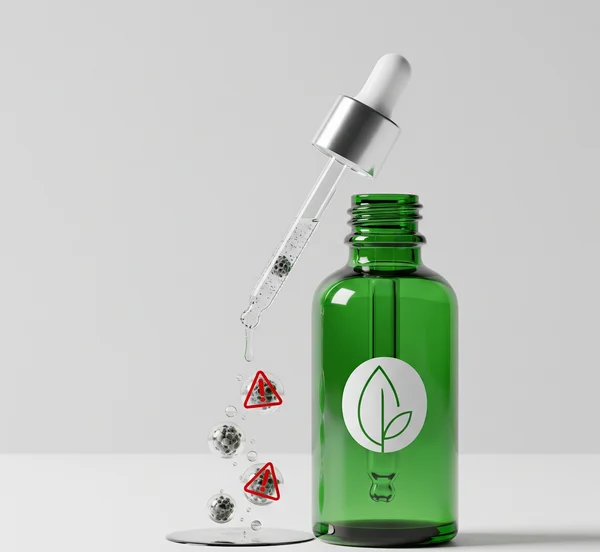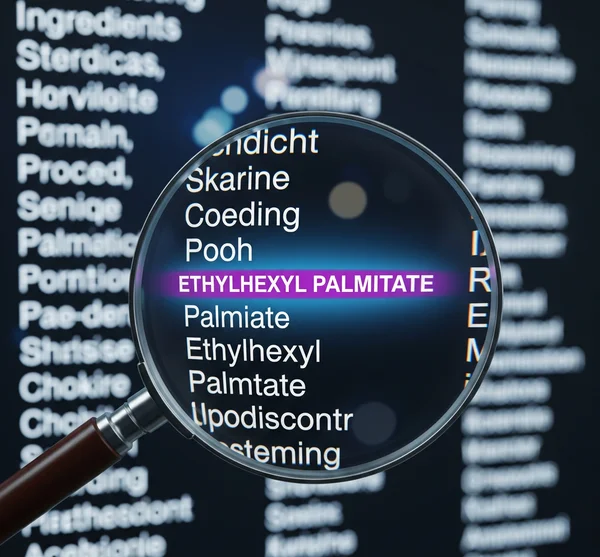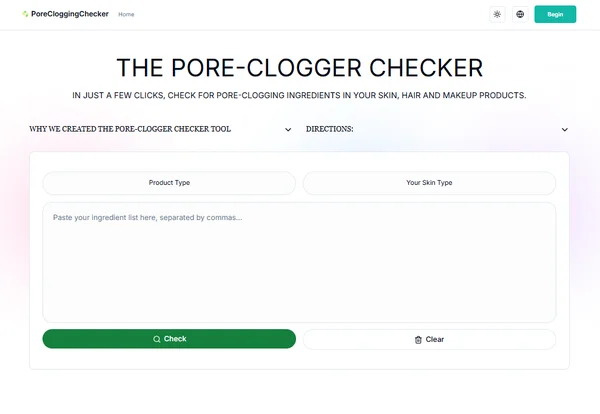7 ingrédients sournois susceptibles d'obstruer vos pores
Vous avez fait vos recherches. Vous évitez consciencieusement l'huile de coco dans votre crème hydratante pour le visage, évitez le beurre de cacao, et vous ne rêveriez pas d'utiliser un produit avec une forte concentration de lanoline. Pourtant, vous continuez à avoir des éruptions cutanées mystérieuses et des pores obstrués. Quels sont les ingrédients cachés qui obstruent les pores ? C'est une situation frustrante qui amène beaucoup de gens à se demander : "Pourquoi mon produit non comédogène me donne-t-il des boutons ?" La vérité est que, au-delà des coupables bien connus, il existe de nombreux ingrédients "sournois" qui obstruent les pores, dissimulés à la vue de tous dans les listes d'ingrédients. Ce guide dévoilera 7 de ces obstructeurs de pores cachés et vous montrera comment vérifier les ingrédients obstruant les pores comme un pro. Pour une analyse plus approfondie, notre vérificateur d'ingrédients en ligne est un outil essentiel.
Coupable Sournois 1 : Certains Alcools Gras (Pas Ceux Qui Assèchent)
Lorsque les gens voient "alcool" sur une liste d'ingrédients, ils pensent souvent aux alcools desséchants comme l'alcool SD. Cependant, les alcools gras sont complètement différents.
Pourquoi Ils Sont Utilisés (par exemple, l'alcool cétylique, l'alcool stéarylique)
Les ingrédients comme l'alcool cétylique, l'alcool stéarylique et l'alcool cétéarylique sont des substances cireuses utilisées comme émulsifiants (pour maintenir l'huile et l'eau mélangées), épaississants et émollients (pour adoucir la peau). Ils sont incroyablement courants dans les lotions et les crèmes.
Potentiel comédogène pour certaines personnes
Bien que bénéfiques pour beaucoup, ces alcools gras ont un indice de comédogénicité modéré (souvent 2 à 4 sur 5) pour certaines personnes. Pour les peaux à tendance acnéique, ils peuvent parfois être un ingrédient obstruant les pores inattendu.
Coupable Sournois 2 : Des Esters Spécifiques Au-Delà du Myristate d'Isopropyle
La plupart des utilisateurs avertis de soins de la peau savent qu'il faut éviter le myristate d'isopropyle. Mais ce n'est qu'un membre d'une grande famille d'ingrédients appelés esters.
Que Sont les Esters ? (par exemple, le palmitate d'éthylhexyle, le myristate de myristyle)
Les esters sont formés en faisant réagir un alcool avec un acide et sont souvent utilisés pour donner aux produits une sensation lisse, soyeuse et non grasse. Les ingrédients comme le palmitate d'éthylhexyle (également connu sous le nom de palmitate d'octyle) et le myristate de myristyle sont des substituts courants de l'huile minérale.
Leur rôle dans la création d'un toucher "soyeux" et pourquoi ils peuvent être risqués
Bien qu'ils offrent une texture élégante, beaucoup de ces esters sont des ingrédients comédogènes connus, avec des indices souvent dans la gamme de 2 à 4. Ils sont des obstructeurs de pores cachés courants dans les soins de la peau et le maquillage.
Coupable Sournois 3 : Extraits d'Algues (Carraghénane et Autres)
"Naturel" ne signifie pas toujours sans danger pour les pores. Certains extraits d'algues en sont un excellent exemple.
Le piège du 'naturel' : pourquoi les algues peuvent être comédogènes
Les ingrédients comme la carraghénane, l'algue rouge et l'extrait de plancton sont riches en nutriments et peuvent être excellents pour l'hydratation, mais ils sont également connus pour avoir un potentiel comédogène élevé pour certaines personnes. Ils peuvent stimuler une réaction dans le follicule qui conduit à l'obstruction.
Où Vous Pourriez Les Trouver
Vous trouverez souvent ces extraits d'algues dans les sérums hydratants, les crèmes gel et les masques. Bien que ce ne soit pas un problème pour tout le monde, ils sont une source fréquente de confusion pour ceux qui ont des éruptions cutanées à cause de produits soi-disant "sûrs" ou "naturels".

Coupable Sournois 4 : Certains Tensioactifs Dans les Nettoyants
Vous pourriez penser que votre nettoyant élimine tout, mais certains tensioactifs (agents nettoyants) peuvent laisser un résidu qui obstrue les pores.
Au-delà du SLS : des tensioactifs plus doux et leurs problèmes potentiels
Bien que le laurylsulfate de sodium (SLS) soit connu pour être dur, même certains tensioactifs plus doux ont été signalés dans certaines listes de comédogénicité. Le problème est que certains peuvent être irritants ou ne pas se rincer proprement, laissant un film qui peut contribuer à l'obstruction des pores au fil du temps.
Coupable Sournois 5 : La Lanoline et Ses Dérivés
Bien que nous ayons mentionné la lanoline dans l'introduction comme un contrevenant plus connu, ses dérivés peuvent être encore plus sournois. Méfiez-vous des ingrédients comme l'alcool de lanoline acétylée, qui est connu pour être un ingrédient obstruant les pores très puissant.
Coupable Sournois 6 : Huiles "Sûres" Spécifiques (comme l'huile de soja ou d'avocat)
Toutes les huiles végétales ne sont pas créées égales. Alors que les huiles comme le tournesol ou le carthame sont généralement considérées comme sûres, d'autres qui sont souvent commercialisées comme saines peuvent être problématiques pour les peaux à tendance acnéique. L'huile de soja et l'huile d'avocat, par exemple, ont des indices de comédogénicité modérés et peuvent être des ingrédients qui obstruent les pores pour certaines personnes.
Coupable Sournois 7 : Certains filmogènes dans les bases et les fonds de teint
Certains polymères utilisés pour créer un film lisse et durable dans les bases de maquillage et les fonds de teint peuvent piéger les débris et le sébum. Bien que n'étant pas toujours officiellement classés comme comédogènes, leur nature occlusive peut entraîner des problèmes si les produits ne sont pas soigneusement retirés.
Comment Devenir un Détective des Ingrédients et Vérifier les Ingrédients Obstruant les Pores

Alors, comment pouvez-vous suivre tous ces ingrédients comédogènes méconnus ?
Ne Vous Fiez Pas à la Mémoire : La Puissance d'un Vérificateur d'Ingrédients
Mémoriser cette liste sans cesse croissante est impraticable. La méthode la plus efficace et la plus fiable est d'utiliser un vérificateur d'ingrédients puissant. Un outil complet comme notre analyseur de formulation en ligne maintient une vaste base de données qui comprend non seulement les coupables évidents, mais aussi ces ingrédients "sournois", vous permettant d'effectuer un examen des ingrédients approfondi en quelques secondes.

Référencement Croisé et Compréhension de Vos Déclencheurs Personnels
Utilisez les résultats d'un outil d'examen des ingrédients et croisez-les avec vos propres expériences. Si vous remarquez que vous avez constamment des éruptions cutanées à cause de produits contenant un certain ingrédient "sournois", vous avez probablement trouvé un déclencheur personnel. Un journal de soins peut vous aider.
Plus de Cachette : Renforcez Vos Choix de Soins de la Peau
Éviter efficacement les ingrédients qui obstruent les pores va au-delà du simple fait d'éviter les contrevenants les plus célèbres. Le monde de la chimie cosmétique est complexe, et de nombreux ingrédients apparemment inoffensifs peuvent être la cause profonde d'éruptions cutanées persistantes.
Devenir un consommateur autonome signifie être vigilant quant à toute la liste des ingrédients. Vous ne pouvez pas vous fier uniquement aux étiquettes "non comédogènes". Prenez l'habitude de vérifier les ingrédients obstruant les pores avec un outil fiable et approfondi. C'est la meilleure façon de démasquer les coupables cachés et de construire une routine de soins de la peau qui soutient vraiment votre peau. Commencez votre analyse détaillée des produits dès aujourd'hui.
Quel est l'ingrédient obstruant les pores le plus surprenant que vous ayez jamais découvert ? Faites-le nous savoir dans les commentaires !
Foire Aux Questions sur les Obstructeurs de Pores Cachés
Répondons à quelques questions courantes :
Q1 : Pourquoi ces ingrédients "sournois" sont-ils même utilisés dans les soins de la peau ?
Ces ingrédients remplissent des fonctions importantes dans une formulation, comme agir comme émollients (adoucissant la peau), émulsifiants (mélangeant l'huile et l'eau) ou épaississants (améliorant la texture). Ils fonctionnent bien pour beaucoup de gens, c'est pourquoi les marques les utilisent. Le problème est leur potentiel à être problématiques spécifiquement pour les peaux à tendance acnéique.
Q2 : Si un produit est étiqueté "non-comédogène", peut-il toujours contenir ces ingrédients ?
Oui. Le terme "non-comédogène" n'est pas strictement réglementé. Une marque peut considérer que sa formule finale est non comédogène en se basant sur ses propres tests ou normes, même si elle contient des ingrédients considérés comme modérément comédogènes par d'autres sources. C'est pourquoi vous devez vérifier les ingrédients vous-même.
Q3 : Comment puis-je découvrir mes ingrédients déclencheurs personnels ?
La meilleure façon est par l'observation attentive et l'élimination. Lorsqu'un produit provoque une éruption cutanée, analysez ses ingrédients à l'aide d'un vérificateur d'ingrédients complet. Notez les ingrédients signalés. Si vous voyez les mêmes ingrédients signalés apparaître dans d'autres produits qui vous causent également des problèmes, vous avez probablement trouvé vos déclencheurs personnels.
Q4 : Ces ingrédients sont-ils toujours mauvais, ou la concentration est-elle importante ?
La concentration est absolument déterminante. Un ingrédient qui est modérément comédogène pourrait être parfaitement bien s'il est à la toute fin de la liste des ingrédients (ce qui signifie qu'il est à une très faible concentration). Cependant, pour les personnes très sensibles ou à tendance acnéique, même de petites quantités peuvent parfois être un problème. Un bon outil de vérification des ingrédients en ligne peut aider, mais l'expérience personnelle est également essentielle.
Q5 : Quelle est la meilleure façon de se tenir au courant des nouvelles informations sur les ingrédients obstruant les pores ?
Suivre des ressources dermatologiques fiables, des communicateurs scientifiques spécialisés dans la peau et utiliser un vérificateur d'ingrédients dont la base de données est régulièrement mise à jour sont les meilleures façons de rester informé. Un outil comme notre Vérificateur d'Obstruction des Pores est conçu pour être une ressource vivante à cette fin.